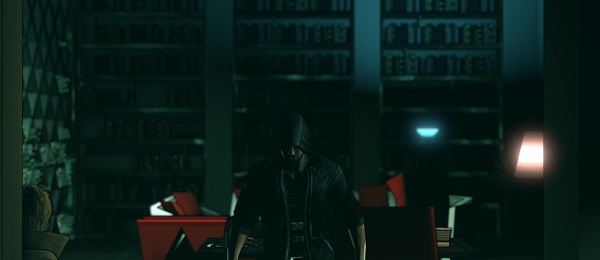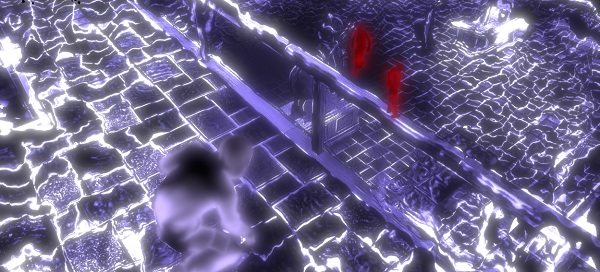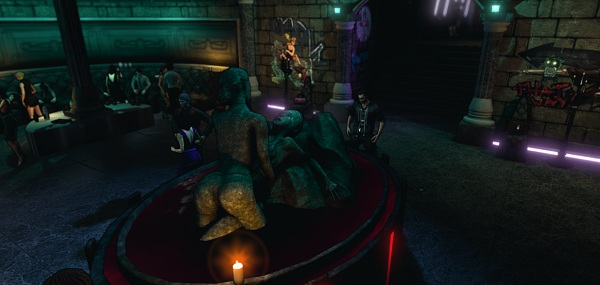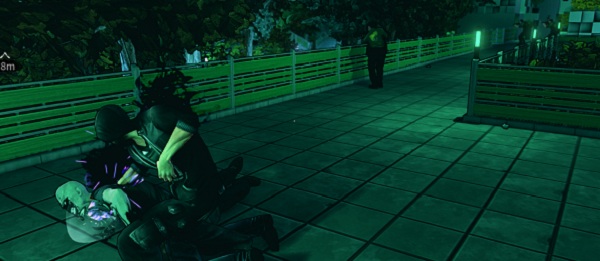Wot I Think: Dark
Bane of my unlife
There's a heatwave sweeping across this part of the world, which means I start to sizzle like bacon on a grill as soon as I pop my head out of the front door. I haven't turned to dust yet or begun to sparkle but I fear that my skin will peel if I don't shelter indoors and I'm becoming increasingly moody about the lack of rain and fog. This makes me the perfect person to step into the shoes of freshly turned vampire Eric Bane. I stepped into the Dark with him this weekend and have returned to tell you exactly wot I think.
Dark begins in darkness. We know this because protagonist Eric Bane’s tells us as much, staggering through a club and fearing that his drink has been spiked, when in reality somebody has spiked and drunk him. With their mouth-spikes. Fangs. A vampire has been necking with poor old Eric, and thanks to a combination of amnesia and being a complete cretin, he is, forgive me, in the dark.
Eric is the most entertaining part of the game – he’s a gruff Geralt-voiced slice of oblivious angst wrapped in pulsating purple shadows and a hoody. I liked him almost immediately and loved him a little bit shortly after he drank a glass of blood and mistook it for a Bloody Mary with a weird aftertaste, or perhaps it was when he had a flashback that he described as ‘realistic’. Eric’s memories have good graphics, evidently. If not then, it was certainly when he finally realised that he was a vampire. To demonstrate his abilities, a friendly bloodsucking bouncer pulls a gun on him and fires. Instincts kick in and Eric ‘shadow leaps’ across the room, a dark blur, dodging the bullet and sliding to a halt on his knees a few metres away.
“Cool moves, dude!” Says the bouncer, which is entirely appropriate to the tone of this potentially terrifying and momentous occasion.
Eric doesn’t even stand up. “What?” He asks, looking over his shoulder as if he’s just been caught tying his shoelaces or trying to pick up a penny that some git has glued to the floor. He sounds fed-up, maybe because he knows what’s coming. Dark is a stealth game, and I’m going to spend the next three days in Eric’s company, dying because he’s clumsy, dying because his powers are shoddy, dying because he can’t jump or pick up a gun or accurately target anything ever.
Seconds after the misting in action episode, our hero has accepted the existence of vampires, his own conversion and is about to set out on the task that is the focus of the game’s six story missions. The plot and its alterations to traditional vampire mythology are delivered rapidly and without fuss. Those who are bitten must feed on their sires or they swiftly become mindless ghouls. Since Eric doesn’t know his sire, having been abandoned shortly after being bitten, he must take an alternative route to salvation - hunting down the city’s most powerful vampires and feeding on their blood in order to retain at least a smidgeon of his own humanity.
This involves entering areas of the city that are notionally inventive – a museum, a skyscraper with artificial biomes – and squatting behind cover while armed guards follow prescribed paths. Considering how often the word ‘dark’ comes up in conversation, second only to ‘pain’, it’s something of a surprise that shadows and light don’t actually affect the sneaking and stalking. Hold down the right mouse button and Eric snaps to nearby cover, making him invisible to anyone on the other side of it.
It doesn’t matter if a light is shining on Eric. Presumably he’s dark enough to negate it, but he must stay out of sight as he traverses these weird spaces, so it’s handy that waist high barriers are conveniently placed at regular intervals. Here’s an experiment: look at the room you are in and imagine that everything, from a table to a coffee mug, was suddenly waist high. The chairs are now barriers that a vampire could be squatting behind, impossible to see. The plant over in the corner? A miscreant may lurk behind the pot, the fronds tickling his chin as he crouches, waiting to strike.
The room is now a maze, a very bland maze, and that’s the room most of Dark takes place in. The size varies as does the colour of the walls and the specific design of the objects, but most areas are like large offices with cubicles routinely placed throughout. There's also very little to interact with. The club that serves as the briefing point between levels as a few characters who will chat, including a DJ who plays the same song on loop for the game's duration, but apart from buying a drink, dancing, stopping dancing and looking at a statue of a vampire's bum, there's nothing else to do.
The abilities, which can be unlocked and improved using experience points, often replace environmental interactions. There are no bottles to pick up and lob across the rooms, for instance, but Eric can cause distractions using his magical abilities. I’m assuming pheromones, sexy vampire pheromones. Whenever a power is selected, its targeting emblem is visible as long as Eric has enough blood stored to use it, which means there’s often a large purple blob floating around and making a nuisance of itself. Then there’s the shadowjump, which doesn’t require blood and has a short cool down. It’s a lot like Dishonored’s blink, a localised teleport, but the positioning of the target location is erratic and there’s no fluidity to the movement.
Despite the constant availability of that motion-based ability, Dark isn’t in the style of Dishonored. There’s precious little vertical movement and Eric is wearing concrete shoes, unable to jump or clamber over any of the many barriers he is destined to meet and to press his cheeks against. Patience is more valuable than skill. Rather than learning environments or behaviours, the challenge is to learn patrol patterns, although which isn’t terrible in and of itself, but the poor AI, which loses track of Eric if he ducks out of sight behind a desk and triggers its ‘alert’ reaction, becoming confused whenever it trips over a corpse, even if already aware that there’s a violent intruder.
Comparing the architectural design to Dishonored’s city would be like comparing Dallas’ Perot Museum to a small cardboard box, and the way that the powers improve while the areas and enemies barely become more threatening or compelling means the player reverses around the learning curve. I’d write more about the combat but there really isn’t any – Eric has one-hit kills that are sometimes deflected and enemies mostly shoot at him until he dies.
The strongest idea is the simplest – sneaking up and chomping down on a neck to charge your powers – but it initially takes so much time and makes so much noise that somehow all the joy is sucked out of it. It doesn’t help that victims’ hands glitch through Eric’s head as he slurps on their contents. In a game with a vampireprotagonist, that such a central and oft-used animation doesn’t look right communicates a great deal about the technical quality of the rest.
Overall, Dark leaves me with the same sinking feeling that always settles in the pit of my mind when I arrive at the unnecessary stealth level in an otherwise entertaining game. Usually they’re of the sort that actively crumple and contort the game’s game’s central mechanics, eventually abandoning them, bending an engine unsuited to the task to the will of shadows and sounds.
Sadly, Dark is that level and it is also an entire game.
Dark is available now.






